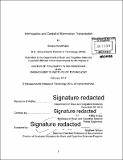| dc.contributor.advisor | Feng Zhang. | en_US |
| dc.contributor.author | Konermann, Silvana | en_US |
| dc.contributor.other | Massachusetts Institute of Technology. Department of Brain and Cognitive Sciences. | en_US |
| dc.date.accessioned | 2017-01-12T18:33:25Z | |
| dc.date.available | 2017-01-12T18:33:25Z | |
| dc.date.copyright | 2016 | en_US |
| dc.date.issued | 2016 | en_US |
| dc.identifier.uri | http://hdl.handle.net/1721.1/106436 | |
| dc.description | Thesis: Ph. D. in Neuroscience, Massachusetts Institute of Technology, Department of Brain and Cognitive Sciences, 2016. | en_US |
| dc.description | Cataloged from PDF version of thesis. | en_US |
| dc.description | Includes bibliographical references (pages 119-128). | en_US |
| dc.description.abstract | Gene expression is dynamic in living systems, enabling environmental adaptation and homeostasis. Transcript levels may change temporarily during distinct phases of biological processes, while longer lasting modifications to their regulatory machinery can lead to specific cell states or disease phenotypes. However, versatile and robust methods to investigate causal relationships between gene expression states and biological phenotypes remain elusive. My thesis work - divided into two main parts - has focused on the development of technologies to enable efficient, generalizable, and precise perturbation of mammalian gene expression. The first part of my research focused on the development of light-inducible transcriptional effectors (LITEs) to mediate positive and negative regulation of endogenous mammalian gene expression (Konermann et al. Nature 2013). Optical stimulation enables precise spatiotemporal control to closely match endogenous transcriptional dynamics. I engineered the LITE system based on the programmable TALE DNA binding proteins from plant pathogens in combination with the light-inducible dimer cryptochrome 2 - cibi from Arabidopsis thaliana. Light enables fast and reversible recruitment of transcriptional effector domains to the TALE bound to the endogenous target promoter through dimerization of cryptochrome 2 - cibi. I applied LITEs to control gene expression in primary neurons as well as in the mouse brain in vivo, demonstrating their potential to dissect genetic contributions to dynamic behaviors such as learning. Epigenetic regulation of transcriptional state is an additional layer of endogenous control exerted by the cell to store more permanent states such as memories. To interrogate epigenetic in addition to transcriptional dynamics, I next developed TALE-mediated targeting of 32 repressive histone effectors to alter epigenetic states in a locus-specific manner. The LITE system establishes a novel mode of optogenetic control of endogenous cellular processes and enables direct testing of the causal roles of genetic and epigenetic regulation in normal biological processes and disease states. One major limiting aspect of TALE-based transcriptional activators is the costly and labor-intensive construction of their repetitive DNA binding domains. As a result, the utility of TALEs for higher-throughput gene targeting experiments remains limited. The CRISPR nuclease Cas9, however, can be easily programmed using a short guide RNA homologous to the target genomic DNA of interest. Additionally, Cas9 can be easily converted into an RNA-guided DNA binding protein (dCas9) via inactivation of its two catalytic domains. The ease and scalability of the CRISPR-Cas9 system potentially enables systematic, genome-scale perturbation, but the magnitude of transcriptional upregulation achieved by the current generation of Cas9 transcriptional activators typically ranges from low to ineffective. In order to achieve a system where the majority of Cas9 activators are highly functional, I undertook structure-guided engineering to generate a potent, sjynergistic Cas9 activation complex (SAM) capable of mediating robust upregulation with a single sgRNA (Konermann et al., Nature, 2015) which outperforms current systems by more than two orders of magnitude. I demonstrated that these transcriptional effectors are capable of activating up to 10 genes simultaneously, allowing for understanding of complex genetic and regulatory networks. Genome-scale GOF screening approaches have largely remained limited to the use of cDNA library systems, which are costly and challenging to use in a pooled format. To overcome this limitation, I designed a genome-scale sgRNA library targeting every coding isoform from the RefSeq database (23,430 isoforms) for a final library of 70,290 guides. I next aimed to identify gain-of-function changes that can lead to the development of BRAF inhibitor resistance in BRAFV 600 mutant melanoma cells. The screen results highlighted a number of gene candidates that both confirm known BRAF inhibitor-resistance pathways and suggest novel mechanisms of action. SAM activators present a highly reliable and generalizable tool for genome-wide interrogation of gene function and interaction in diverse biological processes. Recently, we have extended the utility of the SAM system to enable bimodal control through the use of modified, truncated deadRNAs (dRNAs) (Dahlman, et al., Nature Biotechnology 2015). These dRNAs prevent nucleolytic activity of an active Cas9 nuclease and transform the wildtype enzyme into an efficient transcriptional activator when combined with the SAM activator-components. This system enables simultaneous knock-out of gene A and activation of gene B in the same cell population, enabling bidirectional interrogation of gene interaction and regulatory networks. | en_US |
| dc.description.statementofresponsibility | by Silvana Konermann. | en_US |
| dc.format.extent | 128 pages | en_US |
| dc.language.iso | eng | en_US |
| dc.publisher | Massachusetts Institute of Technology | en_US |
| dc.rights | M.I.T. theses are protected by copyright. They may be viewed from this source for any purpose, but reproduction or distribution in any format is prohibited without written permission. See provided URL for inquiries about permission. | en_US |
| dc.rights.uri | http://dspace.mit.edu/handle/1721.1/7582 | en_US |
| dc.subject | Brain and Cognitive Sciences. | en_US |
| dc.title | Interrogation and control of mammalian transcription | en_US |
| dc.type | Thesis | en_US |
| dc.description.degree | Ph. D. in Neuroscience | en_US |
| dc.contributor.department | Massachusetts Institute of Technology. Department of Brain and Cognitive Sciences | |
| dc.identifier.oclc | 967340866 | en_US |
